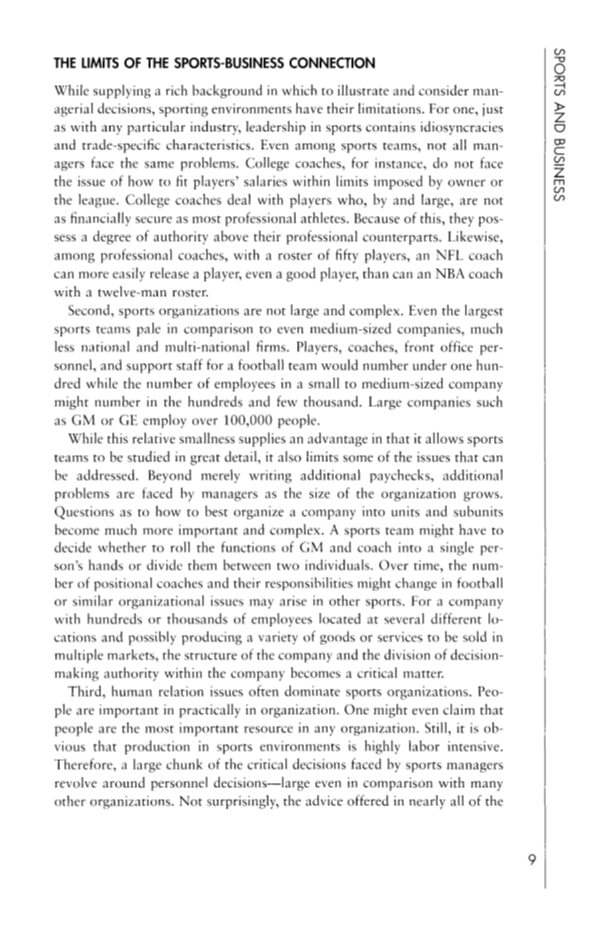THE LIMITS OF THE SPORTS-BUSINESS CONNECTION While supplying a rich background in which to illustrate and consider man- agerial decisions, sporting environments have their limitations. For one, just as with any particular industry, leadership in sports contains idiosyncracies and trade-specific characteristics, riven among sports teams, not all man- agers face the same problems. College coaches, for instance, do not face the issue of how to fit players' salaries within limits imposed by owner or he league. College coaches deal with players who, by and large, are not as financially secure as most professional athletes. Because of this, they pos- sess a degree of authority above their professional counterparts. Likewise, among professional coaches, with a roster of fifty players, an NFL coach can more easily release a player, even a good player, than can an NBA coach with a twelve-man roster. Second, sports organizations are not large and complex. Even the largest sports teams pale in comparison to even medium-sized companies, much less national and multi-national firms. Players, coaches, front office per- sonnel, and support staff for a football team would number under one hun- dred while the number of employees in a small to medium-sized company might number in the hundreds and few thousand. Large companies such as GM or GE employ over 100,000 people. While this relative smallness supplies an advantage in that it allows sports teams to be studied in great detail, it also limits some of the issues that can be addressed. Beyond merely writing additional paychecks, additional problems are faced by managers as the size of the organization grows. Questions as to how to best organize a company into units and subunits become much more important and complex. A sports team might have to decide whether to roll the functions of GM and coach into a single per- son's hands or divide them between two individuals. Over time, the num- ber of positional coaches and their responsibilities might change in football or similar organizational issues may arise in other sports. For a company with hundreds or thousands of employees located at several different lo- cations and possibly producing a variety of goods or services to be sold in multiple markets, the structure of the company and the division of decision- making authority within the company becomes a critical matter. Third, human relation issues often dominate sports organizations. Peo- ple are important in practically in organization. One might even claim that people are the most important resource in any organization. Still, it is ob- vious that production in sports environments is highly labor intensive. Therefore, a large chunk of the critical decisions faced by sports managers revolve around personnel decisions—large even in comparison with many other organizations. Not surprisingly, the advice offered in nearly all of the 9
Document Details My Account Print multiple pages
Print
You have printed 0 times in the last 24 hours.
Your print count will reset on at .
You may print 0 more time(s) before then.
You may print a maximum of 0 pages at a time.
































































































































































































































































